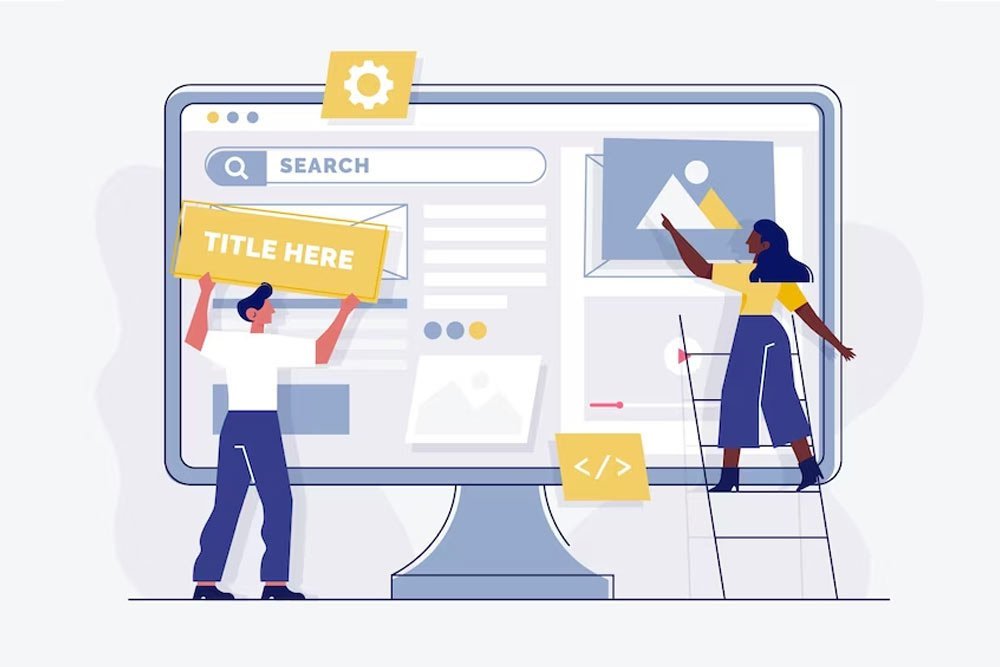In the digital landscape, a well-designed landing page is an indispensable tool for businesses to capture leads, drive conversions, and enhance user engagement. Whether you’re promoting a product, service, or an event, a good landing page can make all the difference in converting visitors into customers. Here’s a concise guide on how to design a compelling landing page that resonates with your audience and achieves your business goals.
- Define Your Objective: Before diving into the design process, clearly define the purpose of your landing page. Are you aiming to generate leads, promote a product launch, or encourage sign-ups for a webinar? Identifying your primary goal will guide the entire design strategy.
- Headline Hero: Captivate visitors with a clear, concise headline that speaks directly to their pain points and highlights your unique solution. Think benefit-driven and attention-grabbing.
- Understand Your Audience: Tailor your landing page design to resonate with your target audience. Conduct thorough research to understand their demographics, preferences, pain points, and motivations. This insight will help you create relevant and compelling content that speaks directly to your audience’s needs.
- Content Clarity: Don’t drown users in text. Keep your copy concise, persuasive, and scannable. Focus on benefits, address audience concerns, and use bullet points and white space effectively.
- Keep it Simple and Clear: Simplicity is key to an effective landing page design. Keep the layout clean and uncluttered, focusing on a single, clear call-to-action (CTA). Avoid overwhelming visitors with excessive text or visual elements, and ensure that the message is concise and easily digestible.
- Craft Compelling Copy: The copy on your landing page should be persuasive and action-oriented. Clearly articulate the value proposition of your offering and highlight the benefits it provides to the user. Use persuasive language to encourage visitors to take the desired action, whether it’s making a purchase, signing up for a trial, or downloading a resource.
- Call to Action (CTA) King: Your CTA is the landing page’s conversion engine. Make it clear, compelling, and strategically placed, using contrasting colors and action-oriented verbs.
- Formidable Forms: Keep forms short and relevant, only asking for information essential for your goal. Reduce friction by minimizing fields and offering auto-fill options.
- Create Visual Appeal: Visual elements play a crucial role in capturing visitors’ attention and conveying your message effectively. Use high-quality images, videos, and graphics that are relevant to your offering and align with your brand identity. Incorporate whitespace strategically to enhance readability and create a sense of balance.
- Less is More: Avoid distractions like navigation links or excessive graphics. Keep the focus laser-sharp on your conversion goal.
- Optimize for Mobile: With a significant portion of internet traffic coming from mobile devices, it’s essential to ensure that your landing page is fully responsive and optimized for mobile users. Test your design across various screen sizes and devices to ensure a seamless user experience.
- Implement Trust Signals: Build credibility and trust with your audience by incorporating trust signals such as customer testimonials, client logos, security badges, and social proof indicators. These elements reassure visitors that your offering is legitimate and reliable, increasing their confidence in taking action.
- Test and Iterate: A/B testing is an invaluable tool for optimizing your landing page for maximum effectiveness. Experiment with different headlines, CTAs, imagery, and layout variations to identify what resonates best with your audience. Continuously analyze performance metrics such as conversion rates, bounce rates, and engagement levels to refine your design and achieve better results.
Which CMS is best to design landing page?
There isn’t a single “best” CMS for landing pages, as the best option depends on your needs and experience level. Here’s a breakdown of some popular options:
Landing Page Builders:
- Easiest to Use: These are great for beginners with drag-and-drop interfaces and pre-built templates. Examples include Unbounce, Instapage, and Leadpages. They typically focus solely on landing pages and may not be ideal for full websites.
Content Management Systems (CMS):
- More Flexibility: These offer more control over design and functionality, but often require some technical knowledge. Here are some popular choices:
- WordPress: The most user-friendly CMS, with tons of plugins and themes for landing pages. However, building landing pages from scratch can be complex. Consider using a landing page builder plugin for a smoother experience.
- Webflow: A powerful option with a visual editor that lets you design complex landing pages without coding. It has a steeper learning curve than drag-and-drop builders but offers more design freedom.
Other factors to consider:
- Budget: Free and paid options are available for both landing page builders and CMS.
- Features: Consider features like A/B testing, analytics integration, and form builders.
- Design Skills: If you’re comfortable with design, a CMS like Webflow might be a good fit. For a simpler approach, consider a landing page builder.
Here are some resources to help you decide:
What are the different types of landing pages?
Lead Capture Landing Pages: These are workhorses of marketing, designed to gather visitor information like email addresses. They typically offer a valuable incentive in exchange, such as an ebook, free trial, or discount code. They are known for being short and focused, with a clear call to action (CTA) to fill out a form.
Click-Through Landing Pages: These pages provide more in-depth information about a product, service, or event. They aim to educate the visitor and nudge them further down the sales funnel. Click-through pages often include features, benefits, and social proof (testimonials, reviews) to build trust and credibility.
Splash Pages: These are essentially temporary intro pages that create anticipation or announce something new. Splash pages might be used for upcoming product launches, registrations for exclusive events, or to collect email addresses before sending users to the main website. They are typically simple and have minimal content, focusing on a single call to action.
Squeeze Pages: A type of lead capture page with an even stronger focus on grabbing email addresses. Squeeze pages are very minimalistic, often just featuring a headline, benefit statement, and a signup form. They are ideal for high-value offers that require more commitment from the visitor.
Thank You Landing Pages: These appear after someone submits a form on another landing page. They express gratitude for the visitor’s action and might offer additional resources or next steps. Thank you pages are a great opportunity to continue nurturing leads and build stronger relationships.
Other Landing Page Types:
Beyond these core types, there are additional landing pages designed for specific purposes:
- Sales Landing Pages: In-depth pages dedicated to selling a product or service, often with longer content and detailed explanations.
- Event Landing Pages: Promote and register visitors for webinars, conferences, or other events.
- Coming Soon Landing Pages: Build anticipation for a new product launch or website redesign.
- Unsubscribe Landing Pages: Allow users to easily unsubscribe from email lists while gathering feedback on why they’re leaving.
The right landing page type depends on your marketing goals and target audience. Consider what action you want visitors to take and tailor your design and content to achieve that specific conversion.
How much content should I include on my landing page?
The amount of content for your landing page depends on several factors, but there’s a golden rule: less is often more.
Here’s why you should keep your landing page concise:
- Attention spans are short: People browsing online are bombarded with information. A concise landing page grabs their attention quickly and delivers the key message before they lose interest.
- Focus on conversions: The goal of a landing page is to get visitors to take a specific action, like signing up for a newsletter or buying a product. Too much content can distract them from that call to action (CTA).
- Mobile-friendliness: A large portion of web traffic comes from mobile devices. A concise landing page loads faster and offers a better user experience on smaller screens.
However, there is some essential content you should include:
- Compelling Headline: This is your first impression, so make it clear, concise, and benefit-oriented.
- Value proposition: Explain what you’re offering and why it’s valuable to the visitor.
- High-quality visuals: Images, videos, or infographics can enhance your message and break up text.
- Social proof: Testimonials, logos of trusted clients, or stats can build trust and credibility.
- Clear call to action (CTA): Tell visitors exactly what you want them to do, and make the CTA button prominent.
Here are some additional tips for managing content length:
- Prioritize: Identify the most critical information visitors need to convert and focus on that.
- Use bullet points and short paragraphs: This makes your content scannable and easy to digest.
- Consider using explainer videos: Videos can effectively convey complex information in a concise way.
Ultimately, the best way to determine the optimal content length is through A/B testing. Create different versions of your landing page with varying content amounts and see which one performs better in terms of conversions.
What kind of copywriting is most effective for landing pages?
Landing page copywriting thrives on a specific type of writing that prioritizes conversions. Here are some key elements that make landing page copywriting effective:
- Benefit-oriented: People care more about what your product or service can do for them than its features. Focus on the benefits that solve their problems or improve their lives.
- Clear and concise: Keep your sentences short and to the point. People skim online content, so prioritize clarity and avoid jargon.
- Actionable: Tell visitors exactly what you want them to do with a strong call to action (CTA). Use action verbs and clear button text.
- Persuasive: Use language that builds trust, urgency, and scarcity (limited-time offers). Highlight social proof (testimonials, reviews) to add credibility.
- Benefit-driven headlines: Your headline is the first thing visitors see. Make it benefit-oriented, grabbing attention and sparking interest.
- Problem-agitation: Briefly acknowledge the challenges or pain points your target audience faces.
Here are some additional tips for writing effective landing page copy:
- Target your audience: Use language and examples that resonate with your ideal customer.
- Focus on emotional triggers: Tap into emotions like fear of missing out (FOMO) or the desire to improve their lives.
- Benefit over features: Don’t just list features; explain how they translate into benefits for the visitor.
- Readability matters: Use a conversational tone and write at a clear reading level.
- Benefit-focused bullet points: Use bullet points to highlight key benefits in a scannable way.
Are there any SEO considerations for landing pages?
Here are some key SEO practices for landing pages:
- Keyword research: Identify relevant keywords with high search volume and low competition that target the conversion intent of your landing page.
- Optimize page title and meta description: Include your target keywords naturally within your page title and meta description. These elements are displayed in search results and can influence click-through rates.
- Strategic keyword placement: Incorporate your target keywords throughout your landing page content, but avoid keyword stuffing. Focus on user experience and readability.
- Image optimization: Use relevant keywords in your image alt tags to help search engines understand the content of your visuals.
- Mobile-friendliness: Ensure your landing page is responsive and provides a good user experience on mobile devices. Google prioritizes mobile-friendly websites in search results.
- Internal linking: Link to your landing page from relevant pages on your website. This helps search engines understand the importance of your landing page and distribute authority.
By following these essential steps, you can design a high-converting landing page that captivates your audience, drives action, and contributes to the success of your marketing campaigns. Remember to prioritize user experience, clarity, and relevance throughout the design process, and don’t hesitate to iterate and refine your approach based on feedback and data insights.

